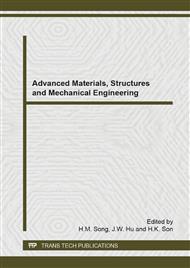[1]
S. Weimin, J. Shengju and L. Fengwei: Icing Research for Airfoil and Multi-element Airfoil, 24th AIAA Applied Aerodynamics Conference, AIAA 2006-3647 (2006).
DOI: 10.2514/6.2006-3647
Google Scholar
[2]
C. Giulio, C.E. De and W.G. Habashi: FENSAP-ICE: Numerical Prediction of In-flight Icing Roughness Evolution, 1st AIAA Atmospheric and Space Enviroment Conference, AIAA 2009-4126 (2009).
DOI: 10.2514/6.2009-4126
Google Scholar
[3]
Z. Zhihong, L. Fengwei, L. Guangning, et al.: Icing Numerical Simulation for Single and Multi-Element Airfoils, 28th AIAA Applied Aerodynamics Conference, AIAA 2010-4232 (2010).
DOI: 10.2514/6.2010-4232
Google Scholar
[4]
A.R. Gary and M.B. Brian: Users manual for the NASA LEWICE ice accretion prediction code (LEWICE), NASA CR-185129 (1990).
DOI: 10.2514/6.1995-752
Google Scholar
[5]
T. Hedde and D. Guffond: Improvement of the ONERA 3D Icing Code, Comparison with 3D Experimental Shapes, AIAA 93-0169 (1993).
DOI: 10.2514/6.1993-169
Google Scholar
[6]
M.G. Potapczuk: Colin S Bidwell. Swept Wing Ice Accretion Modeling, AIAA-90-0756 (1990).
DOI: 10.2514/6.1990-756
Google Scholar
[7]
B.W. William: User Manual for the NASA Glenn Ice Accretion Code LEWICE: Version2. 2. 2. NASA/CR211793 (2002).
Google Scholar
[8]
Fluent 6. 0 User's Guide, Fluent Inc. (2001).
Google Scholar
[9]
Y. Bourgault, W.G. Habashi, J. Dompierre, et al.: An Eulerian Approach to supercooled Droplets Impingement Calculations, American Institute of Aeronautics and Astronautics (1997).
DOI: 10.2514/6.1997-176
Google Scholar
[10]
S. Wirogo and S. Srirambhatla: An Eulerian method to calculate the collection efficiency on two and three dimensional bodies, AIAA 2003-1073 (2003).
DOI: 10.2514/6.2003-1073
Google Scholar
[11]
E. Iuliano, V. Brandi, 0 G. Mingione: Water Impingment Prediction on Multi-Element Airfoils by Means of Eulerian and Lagrangian Approach with Viscous and Inviscid Air Flo, 44th AIAA Aerospace Sciences Meeting and Exhibit, AIAA 2006-1270 (2006).
DOI: 10.2514/6.2006-1270
Google Scholar
[12]
Z.L. Tong and E.A. Luke: Eulerian simulation of icing collection efficiency using a singularity diffusion model, AIAA 2005-12466 (2005).
DOI: 10.2514/6.2005-1246
Google Scholar
[13]
W.Q. Tao: Numerical Heat Transfer (Second Edition), Xi'an: Press of Xi'an Jiaotong University (2001).
Google Scholar
[14]
A. Rothmayer and J.W. Tsao: Film Runback on an Airfoil Surface, AIAA-2000-0237 (2000).
DOI: 10.2514/6.2000-237
Google Scholar
[15]
H.H. Chen and C. Tuncer: A Turbulence Model for Iced Airfoils and Its Validation, AIAA-92-0417 (1992).
Google Scholar


